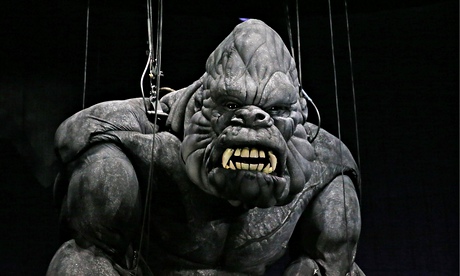King Kong was born way back in 1933 and has since made his way into two movie remakes, one in 1976 and in 2005, a cartoon series, comics, books, and countless examples of merchandise. Not bad for a behemoth gorilla known for rampaging across New York City. Most recently King Kong has been made into a musical. While it would have been entertaining (for the wrong reasons) if the musical featured a normal sized man in a poorly made gorilla suit, singing his lamentations of being misunderstood and mistreated, the production company company took a different approach. The 2013 musical featured a giant 20-foot tall part-robot part-marionette gorilla.
Picture a gorilla puppet. Now picture a robot gorilla. Put those together and you’ve got something pretty cool. Now take that robotic gorilla puppet and make it 20 feet tall, add 1.1 tons of steel, latex, aluminum, and lycra, over 900 ft of electrical cables, 16 microprocessors, hydraulic power with liquid cooling, and 15 servo motors. What you end up with is something that straddles the fence between amazing and terrifying.
As you can imagine, the robo-puppet is incredibly complex and requires a lot of attention to function. It’s not a fully automated unit, but a hybrid requiring puppeteers and the like to facilitate movement. Even with the 15 industrial servo motors, it takes a team of 13 live operators to move the King a single inch! Even with all of those operators, the automation system required to move the gorilla up, down, and around on stage weighs another 10 tons. Basically, this monkey is a big deal.
It took 3 international companies to actually put King Kong together and get it up and running. The effort wasn’t in vain, as the result is truly amazing.
The robotic King Kong looks incredibly lifelike, which is an amazing feat for something that looks so unreal. The face is made of polystyrene-filled muscle volumes, which end up producing some some lip curls and snarls that make you forget you’re watching a robot.
The biggest challenging was fluidly incorporating the mechanical and puppeteering control systems across Mr. Kong’s 50 movement axes. Servo motors are more precise and regular than human movements, so there’s always that potential challenge when trying to combine the two. However, they dialed it in and brought a new, cutting-edge perspective to a beast born back in the 30s.



